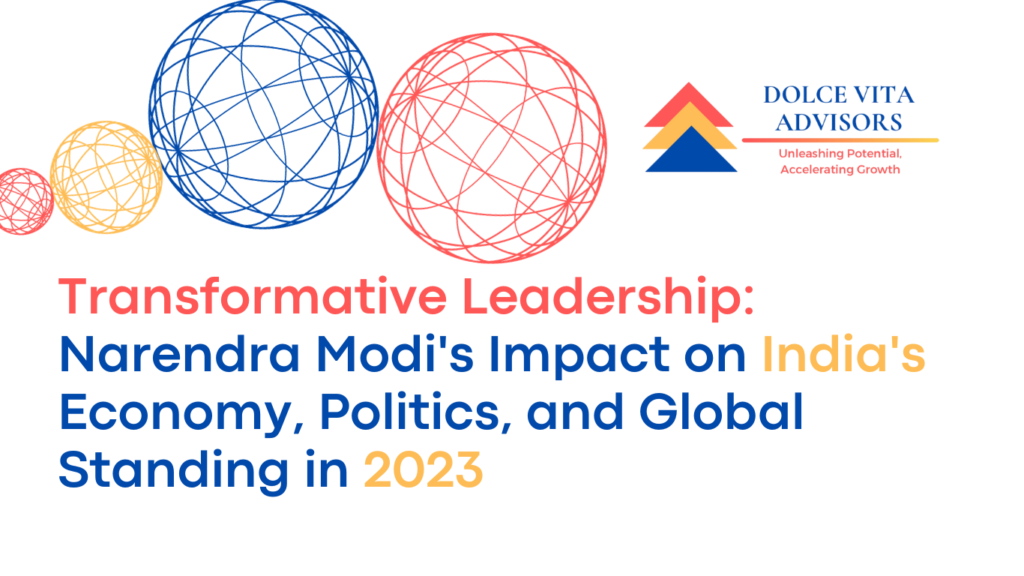
Insights by: Sumit Kochar
Overview
The Narendra Modi-led government in India has been instrumental in composing a remarkable turnaround for the country’s economy. Implementing a slew of transformative policies and strategic initiatives, the government has steered India through a phase of sluggish growth to emerge as the fastest-growing major economy. The launch of visionary schemes such as “Beti Bachao, Beti Padhao” for the welfare of the girl child, leveraging the power of “JAM (Jan Dhan, Aadhar, Mobile)” for financial inclusion, and initiatives like “Make in India” and skill development plans underscore a commitment to holistic development. The recent victory in the December 3, 2023 state elections further solidifies the government’s popularity, demonstrating its ability to secure wins even in closely contested battles. With the GDP registering impressive growth, the Modi government stands poised for continued success. As it eyes the 2024 Lok Sabha elections, the administration’s proven track record and the positive impact of its policies create a strong foundation for a potential return and sustained economic prosperity. Several factors contribute to the likelihood of Prime Minister Modi securing another victory in the 2024 elections and some of them are:
GDP Growth
This year stands as a historic milestone for the Indian economy, undergoing a transformative journey under the NDA Government. From a phase of sluggish growth, elevated inflation, and contracting production, the government has not only fortified our macroeconomic fundamentals but has also propelled the economy towards an upward growth trajectory. India’s Gross Domestic Product (GDP) surpassed expectations by registering an impressive growth of 7.6% in the quarter spanning July to September 2023[1], as per preliminary estimates by the National Statistical Office. This robust performance not only outpaces major economies worldwide but also underscores the effectiveness of strategic policies in fortifying resilience and propelling the nation towards accelerated economic advancement.
Upon assuming office in May 2014, Prime Minister Narendra Modi inherited an Indian economy with a GDP of $2 trillion and a per capita income of $1,573.9. Under his leadership, there has been a remarkable surge, and as of now, India boasts a GDP of $3.73 trillion[2], accompanied by a significant rise in per capita income to $2,601. This substantial economic growth reflects the transformative policies and strategic initiatives implemented during Modi’s tenure.
EY India in its reports predicts that India will emerge as the fastest-growing major economy, anticipating a remarkable six-fold surge in its per capita GDP, exceeding the $15,000 mark by the year 2047[3].
Semi – Final Victory
The results of the December 3, 2023 assembly elections marked a significant triumph for the Bharatiya Janata Party (BJP), securing victories in the key Hindi heartland states of Rajasthan, Madhya Pradesh, and Chhattisgarh in direct battles against the Congress. The outcomes surprised observers on three fronts: the BJP’s robust performance in closely contested battles in Rajasthan and Madhya Pradesh, the unexpected victory in Chhattisgarh contrary to pollsters’ predictions of a Congress win, and the absence of prominent local faces, highlighting the enduring influence of the Modi factor.
Termed a “semi-final” ahead of the impending May 2024 Lok Sabha elections, these results offer political stability assurance to the markets. The BJP’s ability to navigate anti-incumbency factors and secure a substantial victory in Madhya Pradesh (for the fifth consecutive term), coupled with successful reclamation of Rajasthan and Chhattisgarh, positions the party favourably for the upcoming general elections in 2024. While historical trends suggest that state elections may not align with Lok Sabha outcomes, the BJP’s strong performance dissipates a key market concern, reducing political uncertainty over the next five months.
Equity markets, initially apprehensive about the state polls’ implications for the 2024 general elections, have gained confidence with the BJP’s resounding victory. This positive outcome strengthens market trust in the current administration and underscores political continuity post the 2024 Lok Sabha elections. This favourable political landscape bodes well for India’s macroeconomic and policy momentum, particularly when the country is experiencing robust growth among major economies, both in terms of GDP and corporate earnings.
Positive returns in Nifty
Looking ahead, the anticipation is that market sentiment will continue to strengthen, and the likelihood of a pre-election rally is substantial. Notably, historical data reveals that the Nifty has delivered positive returns (ranging from 9% to 36%)[4] in the six months following the announcement of general election results on five previous occasions (1999-2019). This trend underscores the positive impact of political stability on market dynamics, reflecting the resilience and popularity of the Modi government, which has consistently delivered on economic and governance fronts. The enduring success and perceived effectiveness of the Modi government provide a robust foundation for its anticipated return in the 2024 elections.
International Relations
Under the leadership of Prime Minister Narendra Modi, India has undergone a significant transformation in its global standing, emerging as a key player in the evolving dynamics of international relations. The shift began in the 1990s with economic reforms but gained considerable momentum since 2014. Modi’s tenure has witnessed a departure from traditional foreign policy norms, as India actively positions itself as the fulcrum of the emerging world order. This transition aligns with the broader shift from a unipolar to a multipolar global order, offering India a unique opportunity to advocate for an expanded role in global leadership and governance.
The Modi administration’s foreign policy reflects a nuanced and pragmatic approach, projecting moderation, continuity, and stability. India’s active participation in the US-led Quad, despite pursuing an independent foreign policy, showcases a strategic balancing act to safeguard its interests in the Indo-Pacific region. Moreover, the country’s independent stance during the Russia-Ukraine conflict which is reflected in G20 summit held in India recently, resisting external pressure, highlights a commitment to sovereign decision-making and diplomatic solutions. India’s success in developing robust relations with the Islamic Middle East, contrary to initial concerns, underscores its diplomatic prowess and the ability to navigate diverse geopolitical landscapes.
Social Justice and Equality
Over the past nine years, the Narendra Modi government has unwaveringly championed social justice, equality, and equal opportunities for all Indian citizens. Prime Minister Narendra Modi’s campaigns and policies have consistently aimed at fostering a corruption-free, poverty-free, and self-reliant nation grounded in strong social values. Through flagship schemes like Swachh Bharat Mission, Jan Dhan Yojana, Ujjwala Yojana, Ayushman Bharat Pradhan Mantri Jan Arogya Yojana, Make In India, Digital India, and Skill India, the government has positioned itself as ‘pro-poor’ and ‘pro-farmer.’ Further, with a focus on promoting Nari Shakti, Beti Bachao, Beti Padhao among other schemes, the government is dedicated to enhancing women’s lives, addressing challenges hindering their development.
Concluding remarks
The trajectory set by the Narendra Modi-led government has been nothing short of transformative for India’s economy and global standing. The recent triumphs in state elections, coupled with a historic surge in GDP and per capita income, underscore the administration’s effective governance and set the stage for a potential victory in the upcoming 2024 Lok Sabha elections.
Internationally, Prime Minister Modi has skilfully positioned India in the evolving world order, showcasing diplomatic acumen in navigating global dynamics. The government’s commitment to social justice, equality, and comprehensive development is palpable in flagship schemes, reinforcing its pro-poor and pro-farmer narrative. As India charts a course towards sustained economic growth, increased global influence, and societal advancement, the enduring legacy of the Modi government seems destined to leave an indelible mark on the nation’s future.Top of Form
[1] Article, The Hindu, GDP surges 7.6% in Q2, goes past RBI forecast, dated November 30, 2023, available at:
[2] Article, Business Today, India’s GDP is now $3.75 trillion, says FinMin, dated June 13, 2023, available at:
[3] Press release, EY India, EY projects India to become a US$26 trillion economy by 2047 with a six-fold increase in per capita income to US$15,000, dated January 18, 2023, available at:
[4] Article, Business Today, “Stock market: Sensex, Nifty may hit new highs as BJP eyes hat-trick in 2024 elections” dated December 04, 2023, available at:

